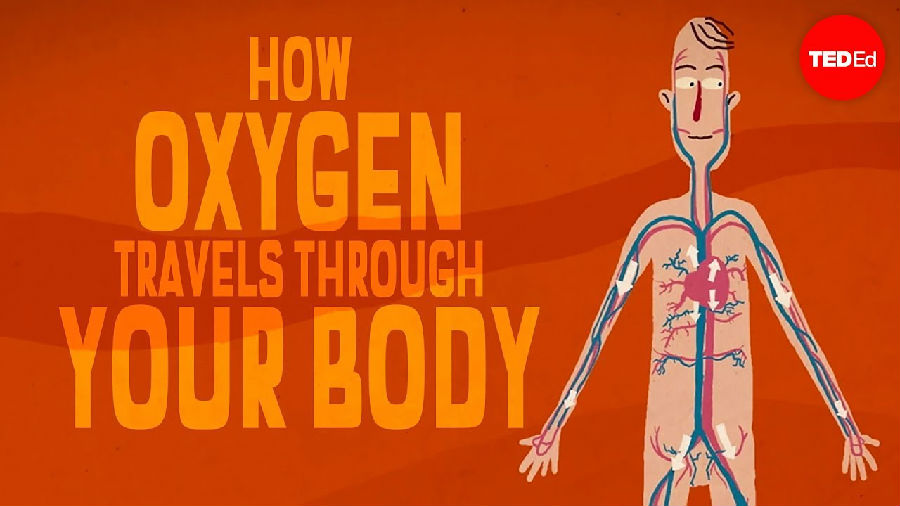(单词翻译:单击)
You breathe in about 17,000 times per day.
你一天大概会呼吸17000次。
It's a process you rarely think about, but behind the scenes, a huge coordinated effort is playing out.
你很少会注意这个过程,但在这些过程背后,包含着巨大的、协调过的努力。
Your vital organs, the gut, brain, bones, lungs, blood, and heart
你至关重要的器官,肠道、大脑、骨骼、肺、血液、心脏,
work together to sustain your life by delivering oxygen to tissues throughout your body.
它们为了维持你的生命一起工作,通过运输氧气到全身的各个组织。
Most of our cells need oxygen because it's one of the key ingredients of aerobic respiration.
我们身体的大多数细胞都需要氧气,因为它是生物有氧呼吸的要素之一。
That's the process that produces a molecule called ATP, which our cells use to power their many incredible functions.
有氧呼吸能产生叫三磷酸腺苷(ATP)的分子,细胞能使用这种分子发挥出很多不可思议的功能。
But getting oxygen throughout our bodies is a surprisingly difficult task.
但是,把氧气运送到全身是一个困难出奇的任务。
Gas enters cells by diffusing in from their surroundings.
气体通过扩散到周围来进入细胞。
And that only happens efficiently over tiny distances.
当它们之间的距离很小时,气体才能有效地扩散。
So for oxygen to reach the cells within our bodies, it needs a transportation network.
所以,氧气需要一个运输网络,以抵达身体的各个细胞。
This is where our 20 trillion red blood cells come in.
这就是我们体内20万亿红细胞的功能。
Each one contains about 270 million oxygen-binding molecules of hemoglobin, which is what gives blood its scarlet hue.
每个红细胞含有2亿7千万血红蛋白,这些蛋白是导致血液是深红色的原因。
To make these cells, the body uses raw materials that become available from the food we eat.
我们的身体使用从食物中摄取的原材料来制造这些细胞。
So in some ways, you could say that oxygen's journey through the body really begins in the gut.
所以从某种程度上,氧气在我们身体内的旅行是从肠道开始的。
Here, in an amazing display of mechanical and chemical digestion,
这是一个关于物理消化和化学消化的展示,
food gets broken down into its smallest elements, like iron, the building block of hemoglobin.
食物被分解成最小的元素,就像铁,血红蛋白的基本材料。
Iron is carried through the cardiovascular system to the body's hematopoietic tissue.
铁元素通过心血管系统被运送到体内的造血组织。
This tissue is the birthplace of red blood cells, and it can be found enclosed within our bone marrow cavities.
这些组织是红细胞的出生地,这些组织处于骨骼的骨髓腔内。
The kidneys regulate our levels of red blood cells through the release of erythropoietin,
肾脏通过释放红细胞生成素来控制体内的红细胞水平,
a hormone which causes marrow to increase production.
红细胞生成素是一种可以促进骨髓产生红细胞的激素。
Our bodies churn out roughly 2.5 million red blood cells per second,
每秒钟,我们的身体会调动250万红细胞,
a number equivalent to the entire population of Paris,
大概是整个巴黎人口的数量,
so that oxygen that makes it to the lungs will have ample transportation.
来充分地运输肺部氧气。

But before oxygen can even reach the lungs, the brain needs to get involved.
但是在氧气到达肺部之前,大脑需要参与这个过程。
The brainstem initiates breathing by sending a message through your nervous system, all the way to muscles of the diaphragm and ribs.
脑干会通过神经系统发送讯号到横膈膜和肋骨肌肉,从而开始呼吸。
This causes them to contract, thus increasing the space inside the rib cage, which allows the lungs to expand.
这会使肌肉收缩,从而扩大胸腔内的空间,导致肺部扩张。
That expansion drops your lungs internal air pressure, making air rush in.
扩张会降低肺部空气压力,从而让空气进入到肺部。
It's tempting to think of our lungs as two big balloons,
我们可以将肺部想象成两个大气球,
but they're actually a lot more complicated than that. Here's why.
但是实际过程却复杂得多。原因是这样的。
The red blood cells in the vessels within your lungs can only pick up oxygen molecules that are very close to them.
肺部血管内的红细胞只能取得离它们非常近的氧气分子。
If our lungs were shaped like balloons,
如果我们的肺部是气球形状的话,
air that was not in direct contact with the balloon's inner surface couldn't diffuse through.
未能和气球内表面直接接触的空气不能扩散出去。
Luckily, our lungs' architecture ensures that very little oxygen is wasted.
幸运的是,我们的肺部结构保证了氧气不被浪费。
Their interior is divided into hundreds of millions of miniature balloon-like projections called alveoli
它们的内部被分为了好几亿个叫做肺泡的气球状小分区,
that dramatically increase the contact area to somewhere around 100 square meters.
它们能使接触面积增加到大概100平米。
The alveolar walls are made of extremely thin flat cells that are surrounded by capillaries.
肺泡墙是由极细的扁平细胞组成的,它们被毛细血管包围着。
Together, the alveolar wall and capillaries make a two-cell thick membrane
总的来说,肺泡墙和毛细血管组成了2个细胞厚度的薄膜,
that brings blood and oxygen close enough for diffusion.
它们能拉近血液和氧气之间的距离到能进行气体扩散的程度。
These oxygen-enriched cells are then carried from the lungs
然后,这些充满氧气的细胞会被从肺部
through the cardiovascular network, a massive collection of blood vessels that reaches every cell in the body.
通过血管数量巨大的心血管系统,运送到全身的各个细胞。
If we laid this system out end to end in a straight line, the vessels would wrap around the Earth several times.
如果我们把整个系统拉伸成一条直线,这些血管能绕地球好几圈。
Propelling red blood cells through this extensive network requires a pretty powerful pump, and that's where your heart comes in.
在这个巨大的系统中推动红细胞需要一个非常强大的泵,这就是心脏的作用。
The human heart pumps an average of about 100,000 times per day,
人类的心脏一天会跳动平均十万次左右,
and it's the powerhouse that ultimately gets oxygen where it needs to go, completing the body's team effort.
它是一个能把氧气运送到指定地点的能源中心,从而让人体能够运作。
Just think -- this entire complex system is built around the delivery of tiny molecules of oxygen.
想像一下,整个复杂的系统都是围绕着氧气分子的运送系统而建造的。
If just one part malfunctioned, so would we.
如果有一个部位停止运作,整个人体也会停止工作。
Breathe in. Your gut, brain, bones, lungs, blood,
吸进空气。你的肠道、大脑、骨骼、肺、血液、
and heart are continuing their incredible act of coordination that keeps you alive. Breathe out.
心脏会继续这些不可思议的协调工作来维持你的生命。呼出空气。


